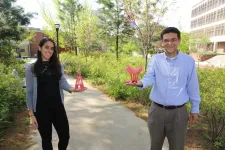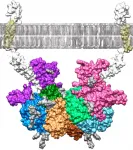Research brief: Improving rug efficacy against prostate cancer and related bone growths
2021-04-20
(Press-News.org) Published in the Advanced Functional Materials, University of Minnesota researcher Hongbo Pang led a cross-institutional study on improving the efficacy of nucleotide-based drugs against prostate cancer and bone metastasis.
In this study, Pang and his research team looked at whether liposomes, when integrated with the iRGD peptide, will help concentrate antisense oligonucleotides (ASOs) into primary prostate tumors and its bone metastases. Liposomes are used as a drug carrier system, and ASOs are a type of nucleotide drug.
More importantly, they investigated whether this system helps more drugs across the vessel wall and deeply into the tumor tissue. This is critical because, although nucleotide drugs offer unique advantages in treating tumors and other diseases, they often suffer from a poor efficiency of crossing the blood vessels and entering the tumor tissue, where their targets reside. This problem greatly limits their clinical applicability and efficacy.
"Our system demonstrates a good ability to deliver more ASOs into both primary tumor tissue and bone metastases -- which is the primary site for prostate cancer metastasis," said Pang, an assistant professor in the College of Pharmacy and a member of the Masonic Cancer Center. "This further translates into a significant improvement of ASO efficacy to inhibit the growth of primary tumor and bone metastases. We expect this system to become a universal carrier system, to improve the clinical efficacy of ASOs and other nucleotide drugs."
The study found that:
iRGD-liposomes can increase the tumor accumulation and vascular/tissue penetration of ASOs against the disease-driving gene of prostate cancer;
the ability of ASOs to inhibit the growth of both primary tumors and bone metastases was significantly enhanced by iRGD-liposomes;
and, a long-term tumor inhibition study was also performed, showing that iRGD-liposomes significantly prolongs the AR-ASO suppression of primary tumor growth.
Pang and his team say that iRGD-liposomes are proven as a desirable delivery system for ASOs, and hold the promise to improve the clinical efficacy of nucleotide drugs in cancer therapies.
INFORMATION:
This study was funded by the National Institute of Health and the State of Minnesota.
ELSE PRESS RELEASES FROM THIS DATE:
2021-04-20
Mass extinctions are known as times of global upheaval, causing rapid losses in biodiversity that wipe out entire animal groups. Some of the doomed groups linger on before going extinct, and a team of scientists found these "dead clades walking" (DCW) are more common and long-lasting than expected.
"Dead clades walking are a pattern in the fossil record where some animal groups make it past the extinction event, but they also can't succeed in the aftermath," said Benjamin Barnes, a doctoral student in geosciences at Penn State. "It paints the pictures of a group consigned to an eventual extinction."
The scientists found 70 of the 134 orders of ancient sea-dwelling invertebrates they examined could ...
2021-04-20
The observation that most of the viruses that cause human disease come from other animals has led some researchers to attempt "zoonotic risk prediction" to second-guess the next virus to hit us. However, in an Essay publishing April 20th in the open access journal PLOS Biology, led by Dr Michelle Wille at the University of Sydney, Australia with co-authors Jemma Geoghegan and Edward Holmes, it is proposed that these zoonotic risk predictions are of limited value and will not tell us which virus will cause the next pandemic. Instead, we should target the human-animal interface for intensive viral surveillance.
So-called zoonotic viruses ...
2021-04-20
In many species, including humans and mice, the fluctuating levels of the hormones progesterone and estrogen determine whether the female is fertile or not. And in the case of mice, whether she's sexually receptive or not.
The change in receptivity is striking. Female mice shift from accepting sexual partners to aggressively rejecting them across a cycle of six short days. How can the female reproductive hormones bring about such a radical behavioural change?
When searching for an explanation, the team of Susana Lima, a principal investigator at the Champalimaud Centre for the Unknown in Portugal, came across an intriguing discovery.
"Our experiments revealed that a brain area important for female receptivity, called the VMH (ventromedial ...
2021-04-20
A chemist from Purdue University has found a way to synthesize a compound to fight a previously "undruggable" cancer protein with benefits across a myriad of cancer types.
Inspired by a rare compound found in a shrub native to North America, Mingji Dai, professor of chemistry and a scientist at the Purdue University Center for Cancer Research, studied the compound and discovered a cost-effective and efficient way to synthesize it in the lab. The compound -- curcusone D -- has the potential to help combat a protein found in many cancers, including some forms of breast, brain, colorectal, prostate, lung and liver cancers, among others. The protein, dubbed BRAT1, had previously been deemed "undruggable" for its chemical properties. In collaboration with Alexander Adibekian's ...
2021-04-20
Astronauts who spend extended time in space face stressors such as isolation, confinement, lack of privacy, altered light-dark cycles, monotony and separation from family. Interestingly, so do people who work at international research stations in Antarctica, where the extreme environment is characterized by numerous stressors that mirror those present during long-duration space exploration.
To better understand the psychological hurdles faced by astronauts, University of Houston professor of psychology Candice Alfano and her team developed the Mental Health Checklist (MHCL), a self-reporting instrument for detecting ...
2021-04-20
A Texas A&M researcher is discovering the demographic characteristics that can produce or lessen stress for racial and ethnic minority students in school settings.
The study, recently published in the journal Ethnicity and Disease, collected mental health survey assessments among 389 sixth-graders from 14 Texas public schools in urban areas. Melissa DuPont-Reyes, assistant professor at the Texas A&M University School of Public Health, led the investigation of self-reported depressive-anxious symptoms over a two-year period. This issue of the journal highlighted research by early stage investigators, especially scholars of color, to advance new knowledge ...
2021-04-20
A mollusk and shrimp are two unlikely marine animals that are playing a very important role in engineering. The bodies of both animals illustrate how natural features, like the structures of their bones and shells, can be borrowed to enhance the performance of engineered structures and materials, like bridges and airplanes. This phenomenon, known as biomimetics, is helping advance structural topology research, where the microscale features found in natural systems are being mimicked.
In a recent paper published by researchers at the Georgia Institute of Technology and the Pontifical Catholic University of Rio de ...
2021-04-20
WASHINGTON, April 20, 2021 -- Fiber optic technology is the holy grail of high-speed, long-distance telecommunications. Still, with the continuing exponential growth of internet traffic, researchers are warning of a capacity crunch.
In AVS Quantum Science, by AIP Publishing, researchers from the National Institute of Standards and Technology and the University of Maryland show how quantum-enhanced receivers could play a critical role in addressing this challenge.
The scientists developed a method to enhance receivers based on quantum physics properties to dramatically increase network ...
2021-04-20
Researchers at Johannes Gutenberg University Mainz (JGU) in Germany and the Institute of Molecular Biology of Barcelona in Spain have discovered how the blood plasma protein fetuin-B binds to the enzyme meprin β and used a computer model to visualize their findings. These results could lead to the development of new drugs to treat serious diseases such as Alzheimer's and cancer. Meprin β releases proteins from cell membranes, thus controlling important physiological functions in the human body. However, a dysregulation of this process can trigger the development of Alzheimer's and ...
2021-04-20
Earthquake early warnings can be delivered successfully using a small network of off-the-shelf smartphones attached to building baseboards, according to a study conducted in Costa Rica last year.
In his presentation at the Seismological Society of America (SSA)'s 2021 Annual Meeting, Ben Brooks of the U.S. Geological Survey said the ASTUTI (Alerta Sismica Temprana Utilizando Teléfonos Inteligentes) network of more than 80 stations performed comparably to scientific-grade warning systems.
During six months' of ASTUTI operation, there were 13 earthquakes that caused noticeable ...
LAST 30 PRESS RELEASES:
[Press-News.org] Research brief: Improving rug efficacy against prostate cancer and related bone growths







